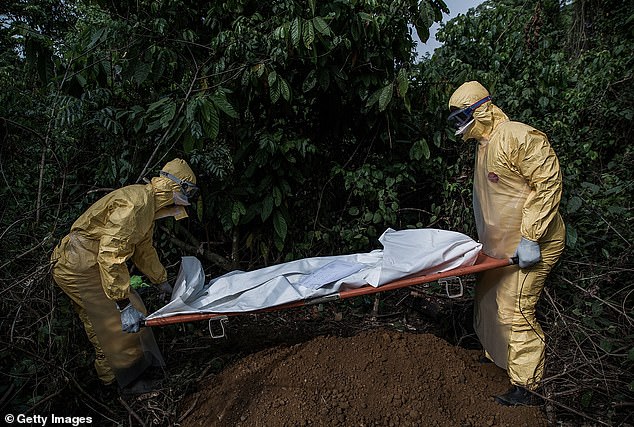Table of Contents
Lassa fever has reached the United States for the first time in a decade, in a case that has surprised health officials.
The middle-aged patient in Iowa, who was not identified, died “shortly” after being hospitalized with the disease, which can cause bleeding in the eyes and seizures.
The patient had just returned to the United States from West Africa, where the disease is endemic and is behind an outbreak in Nigeria, where a total of 9,500 suspected and confirmed cases were reported this year.
Health officials from the CDC and the Iowa Department of Health said the patient had no symptoms while traveling, adding that the risk of transmission was “extremely low” since people are only contagious when they have symptoms.
They did not reveal when the patient began experiencing symptoms, when they returned to Iowa, or say if there were any close contacts.
However, the Iowa case still raised concerns among health experts.
Below, DailyMail.com details everything you need to know about Lassa fever:
Health workers in protective gear bury a 13-year-old boy who died of Lassa fever in 2014 in Sierra Leone (file photo)

An Iowa resident died after contracting a terrifying viral disease, Lassa fever, which is similar to Ebola and leaves victims bleeding from the eyeballs.
What is Lassa fever?
Lassa fever is a serious viral illness that leaves patients with symptoms one week to three weeks after infection.
The disease is endemic in West African countries, including Guinea, Sierra Leone, Liberia and Nigeria, where it is spreading.
Experts say this may be due to a proliferation in the number of rodents in the country that carry the infection, called Mastomys rats, increasing the risk of human infection.
But sporadic cases have also been recorded outside Africa, related to people traveling from the region.
Lassa fever was first discovered in 1969, after two missionary nurses died in the Nigerian town of Lassa from a mysterious illness.
To date, there have been nine cases in the U.S., each linked to recent travel from another country.
How do you get Lassa fever?
Lassa fever is a virus transmitted by Mastomys rats, a rodent species common in sub-Saharan Africa, and does not cause symptoms in rodents.
People get the disease by touching surfaces contaminated with rat urine, droppings or saliva and then touching their mouth.
They can also become infected after eating food contaminated by rats or if the virus gets into an open wound or wound.
Person-to-person transmission can only occur if someone begins to show symptoms of the virus, which tend to begin within a week of infection.
It can be transmitted by touching the individual’s feces, blood, urine, or saliva and then touching your mouth or eating contaminated food.
A person cannot transmit the disease if they do not show signs of infection.
How deadly is it?

About 15 percent of seriously ill patients die from Lassa fever, the World Health Organization suggests.
But Dr. Robert Garry, a professor at Tulane Medical School in New Orleans, suggested Statistical news The mortality rate in severe cases can reach 70 percent in some areas where it is difficult to obtain adequate treatment.
Dr Garry based his higher estimate on his experience working in Sierra Leone, where the virus is endemic and where he has several research projects.
Scientists warn that children under 10 and pregnant women are especially at risk of contracting the disease because they have weaker immune systems. In the case of pregnant women, data shows that more than 95 percent of them abort the fetus.
In one infection, Lassa fever attacks multiple organ systems in the body, including the liver, spleen, kidneys, and the lining of blood vessels.
This can cause inflammation in the organs and prevent them from functioning properly, leading to the death of the patient.
What are the symptoms?
The World Health Organization says about 80 percent of people infected with the virus have no symptoms, meaning they cannot transmit it.
Warning signs tend to begin one to three weeks after infection.
In the early stages, patients may suffer from mild fever, tiredness and weakness, and headache, similar to other hemorrhagic fevers such as Ebola and malaria.
But in later stages, especially if the patient is not treated, the individual may suffer more serious symptoms, such as bleeding from the eyes, vomiting, difficulty breathing, facial swelling, and pain in the chest, back, and abdomen.
How is it detected?
Doctors say diagnosing Lassa fever can be difficult to diagnose because the symptoms vary and are similar to those caused by other illnesses.
In the early stages, symptoms may appear similar to those of malaria, shigellosis, typhoid fever, and yellow fever.
To diagnose an infection, the World Health Organization says that patient samples must be tested in a high-level biosafety laboratory to confirm (and contain) the infection.
Body fluids, such as saliva, blood, or urine, are tested for the virus, and in some cases, fluids collected by lumbar puncture are also tested.
Is there a vaccine?

The map above from the CDC shows the areas of West Africa where Lassa fever is endemic and has been detected.
Doctors use the antiviral drug ribavirin to treat patients with the disease. It is most effective when given soon after the patient shows symptoms.
The CDC also recommends that anyone diagnosed with the disease receive rest, hydration, and other medications to control their symptoms.
The World Health Organization says there is currently no vaccine for the virus and efforts should focus on prevention.
This is based on “good hygiene” and deterring rodents from entering homes, the agency said.
This may include storing food in rodent-proof containers, disposing of trash far from home, keeping a clean home, and having cats, which eat rats.
Can Lassa fever cause complications?
The CDC says about one in three people infected with the virus are left with hearing loss after the initial infection resolves.
The agency warns that this can occur in both mild and moderate cases of the disease.
The CDC also warns that if a pregnant woman is infected, there is a high risk of miscarriage and about 95 percent of fetuses do not survive.
Am I at risk for Lassa fever?
There have been nine cases of the disease in the United States since 1969, including this week’s Iowa patient.
Each of them was related to recent travel abroad, and the patients became ill shortly after returning to the United States. There was no subsequent transmission.
The previous case was reported in May 2015 in a New Jersey resident who had recently traveled to Liberia. The patient also died.
Overall, of the nine patients diagnosed in the United States, at least three have died.
Others survived, but reported being partially deaf and regularly suffering from attacks of pain and severe fatigue.
Experts say the risk of Lassa fever to Americans is low and there are no signs it has spread in the United States.
But they warn there is a risk of infection if someone visits a West African country where the disease is endemic.
The United Kingdom also recorded two cases of the disease in February 2022 in travelers returning from Mali.
There was another case in the UK in 2009, that of a 66-year-old man who had recently returned to Britain from Abuja, Nigeria.
How is the United States handling the recent case?
Iowa authorities isolated the patient in a specialized hospital after he developed symptoms.
The individual was described as having only a “brief illness” before dying.
No further details have been released and the CDC says the risk that the virus has spread is “low.”

